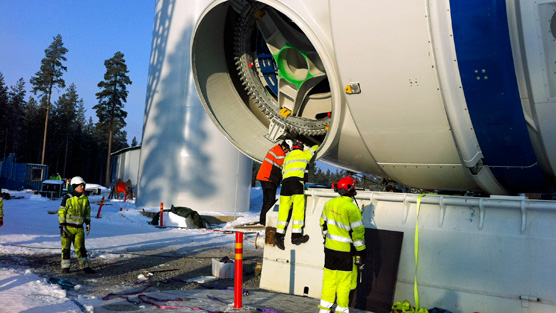Press release 2016-01-14 at 13:57
Press release of the Finnish Environment Institute (SYKE), the University of Oulu, the University of Jyväskylä, Ramboll Finland Ltd and SITO Ltd

Preparations of the Mervento wind power plant in Vaasa. Photo: Feodor Gurvits (EIA picture bank)
New methods make it easier to recognise and systematically assess the most significant environmental impacts of various projects, and to illustrate the results. They also improve the participation possibilities and understanding of citizens and interest groups about the projects and their environmental impacts. The results are from the recently completed IMPERIA project managed by SYKE, and they can be applied all kinds of assessments of environmental impacts.
An environmental impact assessment (EIA) that is carried out well saves the environment and resources, and makes the planning, permit process, and implementation of the project more fluent. There are high and somewhat conflicted expectations for environmental impact assessments, but these expectations are now easier to meet.
The methods created in the IMPERIA project have raised interest abroad as well, for example in Estonia, Sweden and Denmark. The need for applying such methods may increase in the coming years, because as the changes in the EIA directive take effect in 2017, the coordinating authorities must draft a justified conclusion on the significant environmental impacts of their projects.
The ARVI method helps in assessing the significance of the impacts
In environmental impact assessment, one of the biggest challenges is comparing many different types of impacts on nature and the social environment, and recognising the significant ones among them. This situation is greatly improved by the new ARVI method developed in the IMPERIA project and the supporting tool with its instructions.
The ARVI method allows experts assessing different types of impacts to follow uniform principles and to report on the reasoning chains in an illustrative manner. The method is already being used by the largest consulting offices, and it has been applied to eight extensive EIA projects, such as the EIA of the natural gas pipe between Finland and Estonia (Balticconnector) in 2015, and the EIA of the increased use of biofuels by Helsingin Energia in 2014.
Local views must be increasingly considered
One of the observations in the IMPERIA project was that it is a significantly good practice for the improvement of interaction to invite representatives of the key interest groups into a cooperation group which meets several times throughout the project and conveys the local views to the assessors. Utilising local information already in the early stages will help in recognising significant impacts, and may steer the planning towards less adverse alternatives.
Results from the most significant EIA development project in decades now available
The good practices and methods recognised, developed, and applied in the project are compiled in the publication “Good Practices in Environmental Assessments”. The materials and the ARVI tool produced within the project can be found on the project’s website.
Research and practice met in the IMPERIA project
During the IMPERIA project, experts, authorities, and researchers were involved in close dialogue and participated in several training events. Based on the feedback collected, the Finnish EIA experts are well aware of the results and interested in applying them to their work.
The IMPERIA project was carried out by the Thule institute of the University of Oulu, the University of Jyväskylä, Ramboll Finland Oy, and SITO Oy, coordinated by the Finnish Environment Institute SYKE. Funding for the project came from the EU LIFE fund (EU LIFE 11 ENV/FI/905), the Ministry of the Environment, the Ministry of Agriculture and Forestry, and project partners. The duration of the project was 3.5 years, from 1 August 2012 to 31 December 2015.
Why are environmental impacts assessed?
Environmental Impact Assessment (EIA) procedure is applied to projects that may have a particularly harmful impact on the environment. The objective is to reduce or completely prevent the harmful impacts during the construction and use of the project by considering the results in planning and decision-making. It is essential during the assessment process that citizens whose living conditions or interests may be impacted by the project receive sufficient information on the impacts, and that they have sufficient opportunity to influence the various stages of the assessment.
More information
Leading Expert Mika Marttunen, Finnish Environment Institute SYKE, etunimi.sukunimi@ymparisto.fi, tel. +358 295 251 411
Director Jorma Jantunen, Finnish Environment Institute SYKE, etunimi.sukunimi@ymparisto.fi, tel. +358 295 251 217
University researcher Timo P. Karjalainen, University of Oulu, etunimi.p.sukunimi@oulu.fi, tel. +358 50 468 9015
University lecturer Elisa Vallius, University of Jyväskylä, etunimi.sukunimi@jyu.fi, tel. +358 40 805 3871
Leading Expert Sakari Grönlund, SITO Ltd., etunimi.sukunimi@sito.fi, tel. +358 207 476 190
Leading Expert Joonas Hokkanen, Ramboll Finland Ltd., etunimi.sukunimi@ramboll.fi, tel. +358 400 355 260
Communication Specialist Katri Haatainen, Finnish Environment Institute SYKE, etunimi.sukunimi@ymparisto.fi, tel. +358 295 251 135
Links:
Publication: Good Practices in Environmental Assessments
Project: Improving environmental assessment by adopting good practices and tools of multi-criteria decision analysis (IMPERIA)
Environmental impact assessment